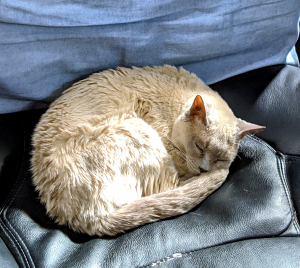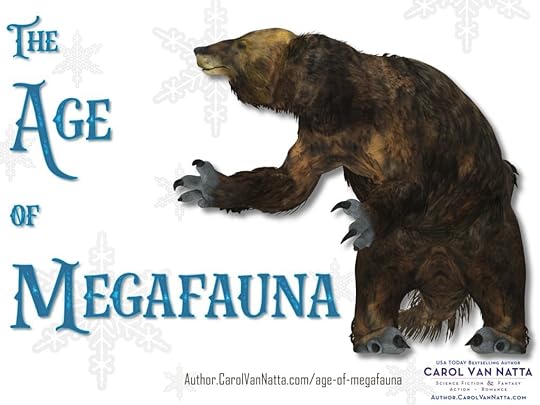Carol Van Natta's Blog, page 11
May 24, 2020
Revisiting World Domination
Revisiting World Domination: Revised Plans for 2020 This time of year, I usually look back at the grand plan I create in January and make minor adjustments. Funnily enough, while my World Domination Plan hoped no calamities would arise, it didn't even contemplate the possibility of a global pandemic. How terribly unimaginative of me. So […]
The post Revisiting World Domination appeared first on Carol Van Natta - Author.
May 10, 2020
Creative Avoidance
Creative Avoidance My general approach to life is to keep busy. It's my way of staving off boredom and countering my DNA-deep slacker nature. On the continuum between “do it now” and “do it when you have to,” I'm in the “do it now” side. But not always. Despite my determination to do a particular […]
The post Creative Avoidance appeared first on Carol Van Natta - Author.
May 3, 2020
IN GRAVES BELOW Spotlight
Today, I'm shining a spotlight on In Graves Below, the first standalone paranormal romance I ever wrote. May 3 is the book's publication anniversary.

The story came about because Amazon invited S.E. Smith (Susan) to participate in the Kindle Worlds program. Authors opened a story universe to other authors, and Amazon handled the details. I was flattered beyond belief when Susan asked me to be one of the inaugural authors for her worlds of Magic, New Mexico. Especially since up to that point, I'd only written scifi space opera romances.
IN GRAVES BELOW Story Origins
In Susan's world, the magical town of Magic, New Mexico was founded in the 1700s as a safe haven for people who were different. As in, witches, werewolves, vampires, dwarves, and anyone else looking to live and let live, and enjoy each other's company without caring who—or what—they are. There's plenty of good fun in Magic.
This got me thinking about what the people who already lived there thought about this new town. Which led me down the research path (my favorite journey!) to find out who was in the area in that era. Various native indigenous tribes called west Texas and southern New Mexico home, but so did the Spanish conquistadors. They swept through and set up missions, more often than not enslaving the natives to build them.
Therefore, to dovetail with Susan's history, I created an earlier alliance between two historical but long-gone tribal groups. Their shamans and spider women foretold the coming trouble and convinced their people to move west. There, they magically claimed land and hid from the would-be conquerors. They thrived for a while, but time has a way of changing things. Today, the once proud clans have dwindled to one family.
In Graves Below stars Idrián Odair, the last shaman. Someday, when my to-be-written list is a little more manageable, I plan to write a second book in this mini-series.

April 26, 2020
Lessons Learned in Pandemic Living
Inspired by a list by my science fiction and paranormal romance author buddy, Susan Kay Quinn, these are my lessons learned while living in a pandemic.
I would live in pajamas forevermore, except cats have needle-sharp claws. As I am averse to having my thighs turned into pincushions, I wear jeans.
Right now, it feels like Tuesday afternoon. However, both the calendar and clock say otherwise. This is merely today's example of Carol Needs A Schedule or her sense of time goes to hell.
The trouble with buying in bulk is that I eat in bulk. Hello, Walkers Shortbread…
 Best second breakfast, ever!
Best second breakfast, ever!We humans need training videos on how to wear masks, and more importantly, the reasons we do so. Wearing them like a chin cradle or lifting them up to cough rather defeats the purpose.
The microphone on my computer is more than adequate for picking up my voice during teleconferences. No need to project into it as if I'm performing in a 1,000-seat theatre.
Exercise improves my productivity and attitude. To accomplish this on my own, I must constantly fight my deeply slacker nature. Also, the cats laugh at me. I miss my exercise classes!
I will not be traveling to certain “open for business!” American states until we have a widely available vaccine for COVID-19. And to the “what, me worry?” governors and mayors who see no need to protect their hospitals and healthcare systems from the inevitable onslaught, I hope your voters remember how little you value your people.
When left unattended, the fun mermaid colors in my hair fade to the quirky pinkish-blonde only seen on the tails of My Little Ponies.
I am guilty of extreme schadenfreude when I read about jerks who horded in-demand commodities, only to discover the only way to even partially recoup their investment is to sell at a loss. Call it instant karma.
My cats have been quite put out that the food being delivered is for humans. Therefore, I ordered $50 worth of catnip toys. Don't judge; you don't have to live with the pushy beasts.

April 19, 2020
Happy Earth Day
I'm extremely fond of the planet we live on, so here's wishing everyone a Happy Earth Day, 22 April. This year, lots of events have moved online for social distancing reasons, but they look amazing. Environmental causes have some great slogans, and climate fiction has come great books.
Clever Earth Day Slogans
People a lot more clever than I am have come up with catchy slogans for Earth Day and environmental causes in general. These are my favorites:
Love Your Mother (Earth) and Your Mother Will Love You
There Is No Planet-B
Heal the Earth • Heal Our Future
If you've got the time, do a quick Google search and look up the evocative posters that go with these.
We humans mostly haven't treated our favorite—only!—planet very well of late. We're kind of like the sometimes well meaning, often careless, and occasionally downright destructive teenager who spills food and instead of cleaning up the mess, invites the dog to lick up the crumbs, then wonders why the floor is sticky and the ants have invaded. The legendary satirist Tom Lehrer wrote Pollution in 1965 (“Don't drink the water, and don't breathe the air!”). Sadly, it's still as relevant today as it was 55 years ago.
Climate Fiction Is Earth's Very Bad Day
One of the newer genres is climate fiction, or “cli-fi” (coined in 2013). Authors and filmmakers explore the ramifications of climate change. Some of these cross over into the disaster category, too. Notable books include:
Fallen Angels by Niven, Pournelle, and Flynn. The subtitle of this could be “Be Careful What You Wish For.” It's a moon colony vs. Earth story with an affectionate hat-tip to science fiction fans. Key events hinge on what happens when an anti-technology movement sweeps the planet and drastically cuts carbon dioxide output.
Octavia Butler's award-winning, bestselling Parable series is set in climate-caused (and human-caused) post-apocalyptic Earth, and explores themes of believe vs. wishful thinking and hope vs. cynicism. Together, Parable of the Sower and Parable of the Talents pack an emotional wallop.
Eve Silver's Northern Waste science fiction romance series is on my top-10 list. It's probably not really cli-fi, but it's set in a new ice age caused to climate change, so I'm including it here. Read Driven , Frozen , and Hidden . Then help me beg her to write more in this series.

April 12, 2020
Ghosts in the Books
The other day, my cat saw a ghost in my bookcase. At least I assume that was the cause of the suddenly fluffy tail and startled look before he bolted. Just because I'm a skeptic and can't see ghosts in the books doesn't mean they aren't there. Cats have far better senses than I do.
I love the idea of ghosts (but not the scary kind), which is why I include them in my paranormal romances.
The Ghosts of Ice Age Shifters
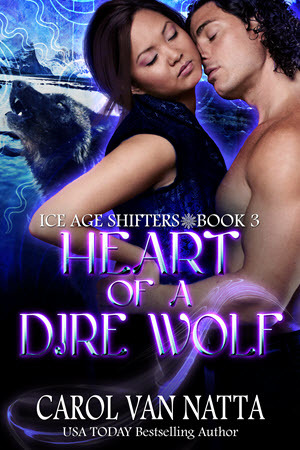 In the Ice Age Shifters® series, the magical world is hidden just out of sight from the mundane world. Which means there's a lot of crossover. Just like in the human world, not everyone believes ghosts exist. In Heart of a Dire Wolf, heroine Skyla believes in them because she sees them every day. Skyla's sister, Rayne, didn't inherit the gift, but believes her.
In the Ice Age Shifters® series, the magical world is hidden just out of sight from the mundane world. Which means there's a lot of crossover. Just like in the human world, not everyone believes ghosts exist. In Heart of a Dire Wolf, heroine Skyla believes in them because she sees them every day. Skyla's sister, Rayne, didn't inherit the gift, but believes her.
Skyla discovered her talent at age 14, right after her mother died, and Skyla saw her first ghost: her own mother. The ghost comforted Skyla and told her how to handle her inherited talent. And more importantly, the responsibilities of such a gift. Here's an excerpt to show you what I mean:
Excerpt from Heart of a Dire Wolf
A shadow crossed the snow. Out of the corner of her eye, she saw an almost human form, but when she looked, it vanished. Whistling sounded with no wind behind it. Fingers danced lightly across the back of her neck, through her collar and drooping bun.
Her temper broke. She stood and faced the buildings, hands before her, robbing from her maned-wolf illusion to form twin spheres of magical explosives. “Any ghost that doesn’t want to be splattered across the cosmos better show itself right now, or leave me the fuck alone.”
A spectral figure wavered in the shadow cast by a tree. “S-s-s-o-o-o-r-r-y-y-y…”
Two more appeared, then three, then five, and in moments, too many to count. Ghosts, specters, and banshees crowded together in the shadows, some crying, some laughing, some howling. Most had lost their living shapes, but a few had vestiges of facial features and clothes. She defused the spell and dropped her hands. She knew what she had to do, but it scared her. She’d only done it once, for one person, not dozens. But if not her, then who?
Family Ghosts: In Graves Below
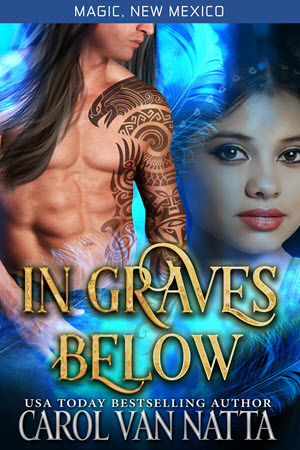 NY Times and USA TODAY bestselling author S.E. Smith created the light-hearted paranormal and scifi romance Worlds of Magic, New Mexico series. Then, she generously opened it up to other writers, including me.
NY Times and USA TODAY bestselling author S.E. Smith created the light-hearted paranormal and scifi romance Worlds of Magic, New Mexico series. Then, she generously opened it up to other writers, including me.
Magic, New Mexico is a mythical town where being abnormal is the norm. Magical denizens—shifters, vampires, witches, aliens from other planets, and more—are free to be who they are, rather than having to hide. The town includes an active ghost community, too. My story in that series is In Graves Below.
Hero Idrián Odair is a disabled veteran. He's also a shaman and almost the last of his tribe. Consequently, he's the keeper of his tribal lands, and all their ghosts. In this world, the ghosts are more substantial. And to Idrián, somewhat more exasperating.
Excerpt from In Graves Below
Idrián shut the truck’s tailgate, then drove the ATV into the barn, the largest building on the property. He knew his friends thought he lived a silent, lonely life on the ranch. He snorted. They didn’t know his spirit ancestors.
“The northeast fence is broken,” complained T’loc’til, an ancient-looking, barefoot man who only manifested a loincloth because the other spirits complained when he bent over.
“Yes,” agreed Idrián. He greeted the patient pinto horse he and his grandfather had raised from an orphaned foal. The pinto directed soft, questing horse lips toward his chest pocket, hoping to find a treat.
“In a minute, Patli.”
The spirit of plain-faced but cheerful Juana Morales drifted into view. “I think the living space would look nice with new curtains.” Thanks to her water-witch powers, the ranch had enjoyed a magical source of under‐ground water since the early 1900s, even during droughts. Idrián tried to conserve it, though, because it was still the edge of the desert.
“It doesn’t have any curtains now,” said Idrián.
“My point exactly,” said Juana, beaming. “I’ll meditate on what color they should be.” She drifted away.
“You didn’t go into town to drink again, did you?” asked Moyolhuani, a short, faded spirit woman from centuries ago.
“Oh, leave him alone,” said her husband, Citlali, only slightly taller and equally faded. “He got drunk once when he was seventeen. He didn’t even drink after that pale-haired uxtl’nòc’tli ji’tclan thought she could steal the ranch.”
“Language,” chided Moyolhuani. “Even though I agree she was a nasty corn blight. Idrián, did you remember the cooking oil?”
The post Ghosts in the Books appeared first on Carol Van Natta - Author.
April 5, 2020
Journalism in the Far Future
In my space opera series, a free and independent press is one of the founding principles of the Central Galactic Concordance. In the far future, journalism has developed new methods, tools, and outlets. However, the fundamental purpose is the same: to shine a bright light on the truth.
The previous government before the CGC was the Central League. They destroyed non-government-owned media sources in their effort to maintain control. However, free journalism flourished on an alliance of breakaway planets, hastening the fall of the Central League.
Personally, I'm a big fan of the free press. As Pres. Thomas Jefferson wrote, “Liberty depends on the freedom of the press, and that cannot be limited without being lost.”
All Digital in the Far Future
In my future universe, the digital revolution is ancient, pre-flight history. This had to happen to make exploration and colonization succeed. Otherwise, you'd have no way to tell the folks back home about the excellent planet you just found, or the exact coordinates of a black hole's event horizon.
That's not to say people don't rely on printed instructions posted for how to use a toilet in null-gravity, or that people don't write notes. It's just that all official records, including words, images, video, and music, are electronic. Databases of the future are called hypercubes. They are huge, self-repairing, and redundant times a thousand. However, they're not perfect. After all, humans invented them and put data in them, so human mistakes get replicated. The heroine in Last Ship Off Polaris-G unearths an abandoned-but-repairable cargo ship that was mistakenly labeled “storage,” so no one looked for it.
Far-Future Journalists Need Skills
Just because the law protects journalism doesn't mean it's a cushy job. First, journalists of the future must know how to write, take flat and 3-D images, record vids (videos) and trids (tri-D videos), and produce their own stories. Second, unless they're independently wealthy, they need a way to make money from their work, usually meaning they must be prolific. Third, speaking truth to power sometimes makes power mad enough to retaliate. As is ever with human civilization, the non-powerful vastly outnumber the powerful, which is why journalists take on the role of “the voice of the people.”
In Minder Rising, the public is incensed by a damning investigative story about how a government agency, the Citizen Protection Service, very likely has a policy of instigating riots as a cover for neutralizing troublemakers. This story helps to set the hero, Lièrén, on the path of questioning the motives of his employer, that same agency. Similarly, if the former residents of Polaris-G someday get justice for what happened to them, it will be because journalists published the true story, not the official coverup version.
In Jumper's Hope, the heroes have information that others will kill to keep secret. They turn to the media to release it, and one journalist in particular: Arco Charrascos. You'll read more about her in Spark Transform. She has quite a number of stories to tell. 
March 29, 2020
Character Naming Secrets
 A reader recently asked if I have any character naming secrets, and where I came up with the name of Mairwen Morganthur, the heroine of Overload Flux. I'll tell you the same thing I told him, but first I must dispel the notion that there any secrets to naming characters.
A reader recently asked if I have any character naming secrets, and where I came up with the name of Mairwen Morganthur, the heroine of Overload Flux. I'll tell you the same thing I told him, but first I must dispel the notion that there any secrets to naming characters.
Just as there are as many spaghetti-sauce recipes as there are cooks, authors have invented countless methods for naming characters. Therefore, what works for me would drive other authors mad, and visa-versa.
By Any Other Name
To begin with, all my story ideas start with characters and the trouble they can get into. Also, since I like justice and hopeful endings, the romance they can find. For the most part, however, those characters don't start out with names. Or at least, the names they end up with. More on that in a minute.
Next, we have to talk about the difference between my space opera universe and the worlds of my paranormal romance series.
The Central Galactic Concordance series is set in the far future, with faster-than-light travel and 500+ settled planets. Humans haven't found any other intelligent species to object, so whenever they find a suitable new planet, they terraform it, then colonize it. Sort of like when a cat rubs on everything in the house to declare ownership. 
March 22, 2020
3 Tips from Carol’s Cats for Living in Uncertain Times
 …………………………………. Cat who is not in the way at all
…………………………………. Cat who is not in the way at allHello. We're Carol's cats. We see that the Interesting Times Fairy has descended, rudely and uninvited, for an extended visit. It's like the old saying, life is what happens when you make other plans. We felines feel your pain and want to help. Therefore, these are 3 tips from us, Carol's cats, for humans living in uncertain times.
Tip #1: Handling Unwanted Change
Unwanted change happens to us cats all the time. Humans feed us different(!) food, under the lame excuse that the grocery store was out of the only acceptable flavor and brand. (What are cars for, if not to drive to other stores?) Or even worse, humans scoop us into the carrier for a visit to the House of Torquemada, a.k.a., the vet. Consequently, we're old pros.
Here are our tips for handling change:
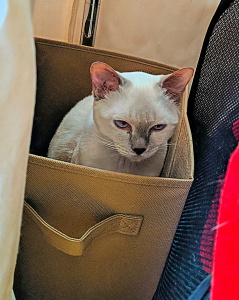 Pout. It's okay to be mad for a while. It's okay to worry or be scared, too. Life will never be the same because it never is. Each day brings something different. We cats find that a good sulk in the cat tower, a meditative visit to the blanket fort, or savaging the shark-shaped cat toy helps us work through this and figure out what to do next.
Pout. It's okay to be mad for a while. It's okay to worry or be scared, too. Life will never be the same because it never is. Each day brings something different. We cats find that a good sulk in the cat tower, a meditative visit to the blanket fort, or savaging the shark-shaped cat toy helps us work through this and figure out what to do next.Pet us. It's a scientific fact that humans with pets are calmer than humans without pets. When we want to sit in your lap or help with what you're doing, we aren't pestering you. We're worried that's you're worried, and want to make you feel better. Besides, we're all in this together. Pet us.
Take a nap. No, seriously. Sleep does wonders for treating stress and giving you new perspective. Not forever, because then you'd miss dinner.
Make a schedule. Figure out times for the new things you have to do and workarounds for the things you can't. It takes effort to set new habits, but pretty soon, they'll become routine. BTW, cats live for schedules. Don't believe us? Try sleeping past our breakfast time and find out.
Decide the change was your idea in the first place. Embrace it and make it your own. Our humans sing a catchy tune about “always look on the bright side of life,” but to us, it's just practical energy conservation. WANT takes less energy and is more fun than DO NOT WANT.
Tip #2: Physical Distance Doesn't Have to Be Social Distance
We cats were perplexed when our household servants, a.k.a. the humans, began staying home even more than they did before. When we asked, they showed us this serious chart as vastly improved by epidemiologist Amy Marie Darling to explain about slowing the spread of that nasty case of COVID-19 crud that's going around.
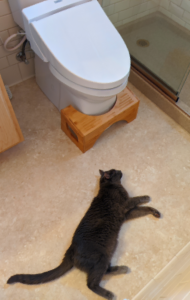 The scientist human called it “Cattening the Curve,” and we approve. Alert kitty will swat you upside the head right damn now. Lazy kitty will bop you when he gets around to it the next few months, but by that time, the caregivers will be ready and hospitals will have room if you need it.
The scientist human called it “Cattening the Curve,” and we approve. Alert kitty will swat you upside the head right damn now. Lazy kitty will bop you when he gets around to it the next few months, but by that time, the caregivers will be ready and hospitals will have room if you need it.
Since viruses are like fleas looking for a new home, a.k.a. other humans, physical distance is the key. Stay a double-arm's length away from fellow humans and you'll be safe. Stay in your own home and be even safer. Plus, since you can't always tell right away if you have fleas or viruses, you won't be spreading those sneaky little bugs to others.
But physical distancing doesn't have to be social distancing. You can still check in with your neighbors to make sure they're okay, or text your friends just to say hi. Our human named Carol already uses Zoom or Skype to interact with people all across the planet. Australia looks like a fun place. She says this helps her extrovert friends who like people as much as we like catnip.
On the other paw, the resident mad scientist much prefers kitties over humans, so to him, social distancing is just another day ending in “y.”
And no hoarding, because that's not just social distancing, that's anti-social. Unless it's catnip. Here's a free tip: Buy some seeds and grow your own. Can't have too much catnip, we always say.
Tip #3: Grooming 101
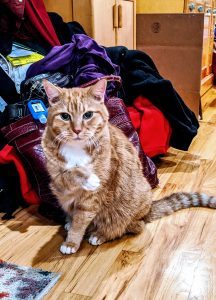 How shall we put this nicely… you humans suck at keeping clean. Oh sure, you groom regularly (by standing or sitting in water—are you insane?), but that's only good until you touch unclean things again, then touch your face. Hello, infection.
How shall we put this nicely… you humans suck at keeping clean. Oh sure, you groom regularly (by standing or sitting in water—are you insane?), but that's only good until you touch unclean things again, then touch your face. Hello, infection.
To be fair, humans do this all the time and usually, bad things don't happen. That's why it's so hard to learn the new habit of not touching your eyes, nose, or mouth until you know your hands are clean. But those nasty bugs can live up to three days on hard surfaces, waiting to pounce on heedless humans.
We know that humans don't even have the patience of a kitten, and couldn't properly spend hours grooming if you tried, but you have to do better than splashing your fingers under water and calling it good. No, it's not. Since you don't have lovely, soft, protective fur, you need 20 seconds with soap and water. Pretend you accidentally grabbed something horribly smelly and need to get it off right now, including between your fingers and out from under your fingernails, before you touch anything else.
Then lick… er, use disinfectant on doorknobs, counters, package exteriors, smart phones, keys, and all the other things you fiddle with.
Now wash your hands again, because you're probably just dying to touch your face. After that, pet us again. It's good for you.

March 15, 2020
The Age of Megafauna
The concept for my Ice Age Shifters® paranormal romance series arose from my hobby of reading science articles. “What if,” I said to my muse, “some shifters were born as throwbacks to the earlier, larger versions of species?” My muse liked the idea, and the series was born. And lucky me, that meant I got to research more animals in the prehistoric age of megafauna.
Iconic Ice Age Megafauna
Thanks to intrepid paleontologists, we have the most information on the more recent extinct species, such as dire wolves, giant sloths, and bears. This is in part because we've found their bones in tar pits and deep caves, also known as “predator traps.” However, in some cases, we have more information because the last of the megafauna were still around to interact with humans. For example, European paleolithic cave paintings suggest humans knew and respected cave lions, the bigger, badder ancestor of today's African lions.
And when it comes to woolly mammoths, we have stronger evidence. Artifacts from early human settlements include tools and carvings of the bones and tusks from woolly mammoths. Of course, humans could have been finding the remains of long-dead animals, but it's a pretty good bet that humans also hunted a few live ones, too.
Megafauna I'd Like to See… from a Distance
Thanks to diligent and patient paleontologists, we have fossil evidence of fascinating creatures from the age of megafauna. However, since “megafauna” means “really big animals,” I'd like to see these creatures from a safe distance.
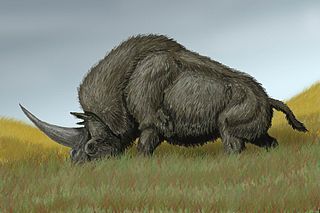 The Age of Grumpy Unicorns
The Age of Grumpy UnicornsThe “giant Siberian unicorn,” otherwise known as Elasmotherium, a giant rhinoceros, flourished during the Ice Age and walked alongside humans. The best known species stood around 7 feet (2 m) tall, were 15 feet (4.5 m) long, and weighed about 8,800 pounds (4 metric tons). However, its signature feature was its amazing horn. Since Elasmotheriums were herbivores, the horn's purpose is still up for hot debate among scientists. But considering how grumpy modern-day rhinos are, I certainly wouldn't want to be chased by a prehistoric one the size of a double-decker bus.
(Image credit: Attribution: DiBgd on Creative Commons)
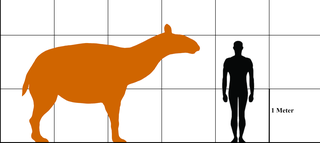 Ice Age in South America, Prehistoric Home of Unique Megafauna
Ice Age in South America, Prehistoric Home of Unique MegafaunaThe Ice Age didn't skip South America. In Shifter Mate Magic, book 1 of the Ice Age Shifters series, the hero, is a bear shifter. Not just any old bear, but an Arctotherium, the largest bear species we've ever found anywhere in the fossil record. Additionally, Dauro, the hero of Shifter's Storm, is an aquatic sloth, another extinct megafauna in South America's age of ice.
South America was also home to a curious, horse-sized creature with the scientific name of Macrauchenia patachonica. Charles Darwin collected a partial skeleton in Patagonia and guessed it was a mastodon. Later examination proved it wasn't big enough for a mastodon, and that it was, well, odd. It had a long, camel-like neck, but with three-toed feet, and possibly, a fleshy snout. Despite plenty of skeletons available, its origin and place in the mammalian clades remained a mystery for 200 years until paleontologists tested the DNA. Turns out, the Macrauchenia is pretty much its own genus, having separated from horses and rhinos some 66 million years ago.
(Image credit: Wikipedia, Creative Commons Attribution-ShareAlike (CC BY-SA) license)
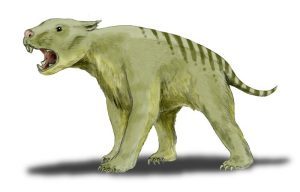 Megafauna Downunder
Megafauna DownunderJust because Australia didn't get covered in show and ice during the last global Ice Age didn't mean the continent didn't have their fair share of megafauna. For example, Thylacoleonidae, the scientific family name for marsupial lions. Paleontologists recently identified a new genus. I should point out that “big” is relative. While marsupial lions had impressively deadly teeth able to easily bite through bone, the largest of them were about the size of a small tiger today. Cave drawings suggest humans met these creatures up close and personal. No thanks; I'll watch from way back here.
I don't know enough about Australia's prehistoric animals and want to learn more. I'd like to put at least one in an upcoming Ice Age Shifters book. Clearly, that means I must go on an educational visit that completely coincidentally includes the towns where my Aussie friends live. 










